Sixty million people are fleeing their homes, two-thirds within their own countries and the rest crossing borders to seek refuge. While the world has never been more generous in responding, offering $28 billion in 2015, the $15 billion gap between humanitarian needs and available financing has never been so wide. We cannot and will not be able to meet the growing crisis with more aid alone. Rather, we need better aid, designed to make the greatest impact with scarce resources and overcome the challenges of modern displacement. As we adapt humanitarian financing and programs based on the following principles—from collective outcomes and evidence to cost-efficiency and transparency—we can begin to transform the humanitarian sector from a collection of disparate actors and mandates into a dynamic, human-centered system.
Collective Outcomes
The first step to having greater humanitarian impact is being clear about what change we are seeking and measuring our progress toward that goal. While the humanitarian system has principles, standards and codes of conduct, it has no shared definition of success. We need a commitment by the international community to clearly name and define the key improvements in health, economic wellbeing, safety, education and power we want to achieve for the people we serve.Some individual organizations, including the IRC, have made commitments to focus on outcomes and measure impact. But doing so in isolation will not allow us to tackle the worst problems facing the humanitarian sector. Lack of agreement on our collective goals—in specific and measureable terms—leads to waste of our already-scarce resources, lack of coordination, and lack of accountability. If we define a collective set of humanitarian outcomes, we establish an organizing principle for the humanitarian sector. We can compare cost-effectiveness of interventions, divide responsibilities beyond blunt sectoral lines, and measure progress against our goals. Actors in humanitarian settings—including humanitarian agencies, development agencies, governments, NGOs, and the private sector—can organize behind joint needs assessments, joint program planning, and common reporting and accountability frameworks. We can measure our progress toward saving and improving lives.
Evidence
Once we agree on a desired outcome, we should use rigorous evidence to identify which types of programs will work best to achieve it. The evidence base for interventions in crisis-affected context is extremely thin, but evidence generation is essential for strengthening our understanding of what works and what doesn’t. We will need an increased investment in impact evaluations, including those that compare one intervention to another. Instead of using a blitz approach, humanitarian actors should identify evidence gaps and strategically ask and answer the question “what works best?” for key outcomes in terms of severity, scale and urgency (or in the likelihood that we may be delivering ineffective or, worse, harmful programs). Humanitarian actors should evaluate to extent to which existing evidence, including that from interventions outside a humanitarian context, can be applied and adapted across settings.
Cost efficiency, effectiveness and results
Because we will always have scarce resources and great need, we must also track and make decisions based on how much interventions cost, in order to get the most value out of every dollar of humanitarian funding. Data-based cost analysis can tell us what it costs to deliver different programs in different contexts, and what factors (such as scale or program coverage rates) really drive cost-efficiency within a single intervention. When combined with impact evaluations, cost analysis can tell us which programs achieve a targeted outcome most cost-effectively. We need better data and more transparency on not only costs but also results, so we don’t just choose the program with the lowest price tag but the one with the highest quality return. We need to move away from the “overhead myth,” which encourages thinking about costs purely in terms of overhead versus program services, and focus on how efficiently organizations turn inputs into outputs, and how effectively the outputs actually achieved their desired outcomes.
Again, individual organizations or donors can dedicate staff time and resources to cost analysis, and improve the efficiency of their own programs or funding. The IRC has developed a software
tool to streamline the analysis process, which we hope to share with our peers. But to create a truly efficient humanitarian system, including one that reduces reporting burdens, donors and implementers must agree on methodology and reporting standards to enable transparent, appropriate and accurate cost comparisons.
Cash
Overwhelming evidence shows that cash transfers are among the most effective, efficient, and fastest interventions to reach people in need. They offer greater flexibility and decision-making power for individuals and families in crisis than typical in-kind aid, and have positive externalities for local markets, access to education, lower child labor, reduced tensions within households, and improved relationships between beneficiaries and host community members. The humanitarian community should commit to rapidly scale up the use and quality of cash transfer programs across
the humanitarian system, ultimately making cash transfers the default humanitarian aid delivery mode in as many contexts as is feasible. Donors and country governments should invest in digital and financial infrastructure, as well as develop procedures to scale social protection systems, so they are prepared to deliver cash rapidly in a crisis.
Responsiveness to protracted displacement
Humanitarian financing and interventions should reflect the reality that displacement is, in the majority of cases, no longer a short- term experience. The average duration of crisis is now 37 years. The typical mode of humanitarian finance, e.g. one-year grants for humanitarian agency-delivered NFIs, is not well-suited to meeting the needs of people in protracted crises. More humanitarian financing should be structured in multi-year agreements, reducing administrative burdens and allowing long-term planning horizons.
Furthermore, we need to rethink the kinds of systems we finance. Decades-old camps are draining the humanitarian system, and creating disparities in dignity and the fulfillment of human potential between refugees and host communities. The growing proportion of displaced people living in urban areas—now 60%—also strains the social protection and physical infrastructure of host countries. These challenges should lead us to break down the divisions between development and humanitarian actors. We need more flexible funding that allows for these direct partnerships and the deployment of responsive solutions. Such solutions and interventions for protracted displacement should be integrated effectively in local and national systems where appropriate, emphasizing the important role that governments play.
Transparency and accountability
Throughout the process of defining outcomes, identifying and generating evidence, tracking costs, and delivering assistance, actors in humanitarian settings are generating data and information. While we must maintain our central mission to protect vulnerable and sensitive populations, we should nonetheless “default to open” where we can. This is especially true with regard to humanitarian financing—we should have much more transparent channels of funding from the highest level of donor appeals down to final responders, and ideally, crisis-affected individuals. Sharing data and information openly allows for greater shared learning, reduced duplication of evidence and analysis efforts, and better coordination. It also provides the mechanism for accountability in the system, shining a light on what is and isn’t working and allowing those we serve to hold us to the highest standards. As we seek to incorporate all the above principles in our humanitarian financing and programs, we must continually reflect on and improve upon our progress in creating a more effective, efficient, flexible, and human-focused humanitarian system.



